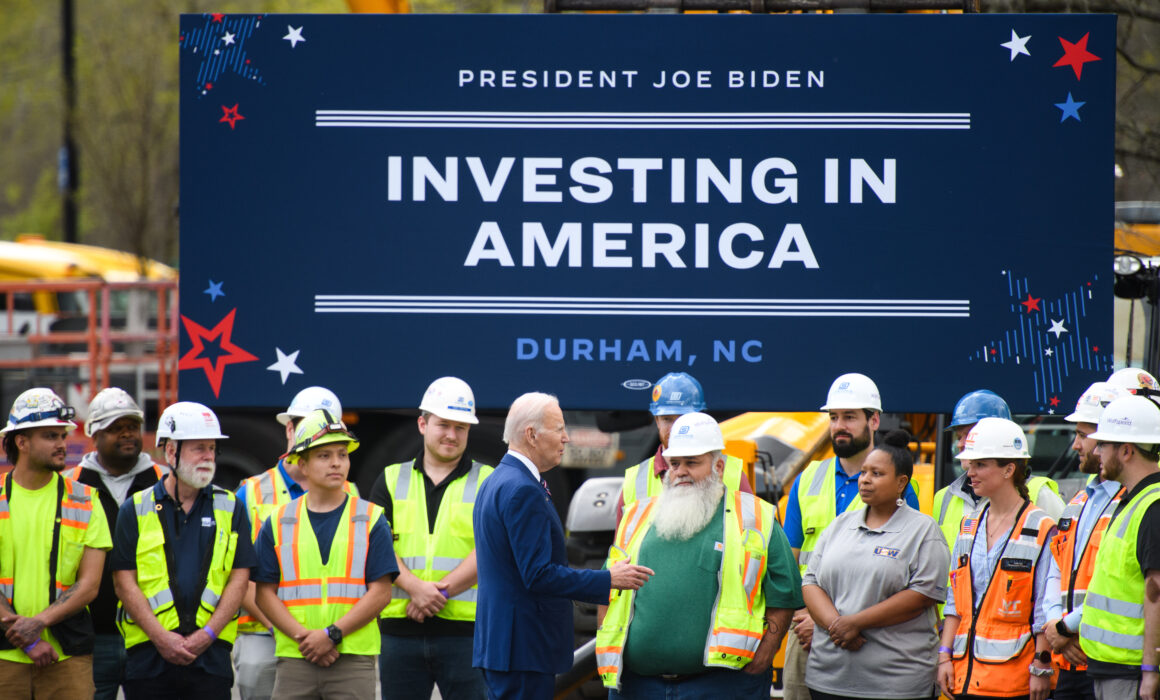The Last Four Years Showed Us What’s Possible
July 25, 2024
Here’s how we can build on those economic wins.
The Roosevelt Rundown features our top stories of the week.
The president greets union workers after visiting a semiconductor manufacturer in Durham, North Carolina, in 2023. (Photo by Melissa Sue Gerrits/Getty Images)
A Government That Invests in Its People
As the Biden administration finishes out its last year, here’s what we know: A major paradigm shift in economic policy is underway. As Roosevelt President and CEO Felicia Wong writes in a new blog post, it’s a shift that prioritizes workers over corporations, public power over unchecked markets, and shared prosperity over trickle-down economics.
The administration’s greatest successes have come where they’ve been willing to embrace progressive ideas, and we’ve seen impressive results. The American Rescue Plan’s prioritization of full employment ushered in a record economic recovery—helping the unemployment rate stay below 4 percent for a historic 30 months—and was followed by investments in industry and infrastructure through the Inflation Reduction Act, CHIPS and Science Act, and Infrastructure Investment and Jobs Act. A revitalized National Labor Relations Board is standing up for labor power and supporting workers’ right to organize, and an aggressive Federal Trade Commission is taking a relentless and innovative approach to antitrust enforcement.
“The future is sensationally unpredictable,” writes Wong, “but one thing is certain: Powerful actors will continue to fight hard to keep the embers of trickle-down thinking alive.” It’s up to us to snuff out the flame. These successes, pushed for by progressive thinkers and advocates who knew that “market supremacy couldn’t deliver what it promised,” have paved the way for what’s left to do: rethinking the tax code to ensure the wealthy pay their fair share, reforming the courts to protect democracy, and investing more resources in care, education, and housing.
Read the blog post: “The Economic Legacy of the Biden Years, and the Path Forward”
Making Industrial Policy Work for Workers
One of the administration’s greatest rebukes against the austerity of neoliberalism was the Inflation Reduction Act (IRA)—the largest investment in green energy in US history. The IRA is supercharging the renewable energy sector and creating tens of thousands of jobs along the way. In a new report, Roosevelt’s Alí R. Bustamante and the Urban Institute’s Joe Peck explain how localities can make sure those jobs are good jobs.
“For communities to reap all the potential benefits of this tremendous job creation, they will need to organize,” write Bustamante and Peck. Companies that use the IRA’s loans and grants are incentivized to prioritize projects that involve collective bargaining agreements or hire disadvantaged workers, but the bulk of firms benefiting from tax credits aren’t held to this standard. This means that many of the “100,000-plus manufacturing jobs created by the IRA will lack any mechanism—guardrail or guideline—that ensures created jobs are good, union jobs.”
The report features case studies in how IRA investments in battery, electric vehicle, and solar panel manufacturing are likely to transform local labor markets in five communities: Georgia, South Carolina, Michigan, Louisiana, and California. The authors argue that “community engagement and democratic governance in the implementation of industrial investments can promote good jobs and deliver substantial economic benefits to local communities.”
As White House National Economic Advisor Lael Brainard said during a Roosevelt webinar about the report’s findings, “This administration is proud to be working with communities all over the country who are turning setbacks into comebacks.”
Read the full report, and watch more from Brainard’s remarks and our panel discussion below:
What We’re Talking About
When states wield their powers strategically, they can shape markets and drive progress, as evidenced by recent US successes.
Policymakers must learn from these successes as well as international examples, as laid out in our #IP2025 series 👏 https://t.co/J0yRY0tpl9 pic.twitter.com/E9mJW19Uqz
— Roosevelt Institute (@rooseveltinst) July 23, 2024
What We’re Reading
Treasury’s Fight to End Businesses Tax Loopholes Just Got Harder – by Roosevelt Senior Fellow Beverly Moran – Bloomberg
Judge Refuses to Block FTC’s Noncompete Ban as Lawsuits Play Out – New York Times
The FTC Is Investigating AI-Powered Surveillance Pricing – The Verge
